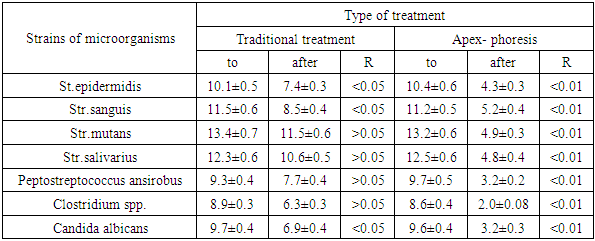-
Paper Information
- Next Paper
- Previous Paper
- Paper Submission
-
Journal Information
- About This Journal
- Editorial Board
- Current Issue
- Archive
- Author Guidelines
- Contact Us
American Journal of Medicine and Medical Sciences
p-ISSN: 2165-901X e-ISSN: 2165-9036
2025; 15(2): 447-448
doi:10.5923/j.ajmms.20251502.37
Received: Jan. 27, 2025; Accepted: Feb. 15, 2025; Published: Feb. 28, 2025

Clinical and Microbiological Assessment of the Quality of Endodontic Treatment of Chronic Apical Periodontitis with Difficult-to-Reach and Impassible Root Canals of Teeth
Jumatov Urazmat Jumatovich, Khabibnazarov Porohat Ribnazarovich
Center for Development of Professional Qualifications of Medical Workers of the Ministry of Health of the Republic of Uzbekistan, Tashkent, Uzbekistan
Correspondence to: Jumatov Urazmat Jumatovich, Center for Development of Professional Qualifications of Medical Workers of the Ministry of Health of the Republic of Uzbekistan, Tashkent, Uzbekistan.
| Email: |  |
Copyright © 2025 The Author(s). Published by Scientific & Academic Publishing.
This work is licensed under the Creative Commons Attribution International License (CC BY).
http://creativecommons.org/licenses/by/4.0/

Based on the conducted studies, it was established that the use of a relatively innovative method – apexphoresis in chronic apical periodontitis with hard-to-reach and impassable root canals of teeth confirmed the greatest antibacterial effectiveness of the applied apexphoresis with a silver-copper conductor in relation to facultative anaerobic microbes, both those most often encountered in periodontitis and those with significant resistance to antibacterial effects.
Keywords: Endodontics, Chronic apical periodontitis, Apexphoresis, Hard-to-reach and impassable root canals of teeth, Quality of endodontic treatment
Cite this paper: Jumatov Urazmat Jumatovich, Khabibnazarov Porohat Ribnazarovich, Clinical and Microbiological Assessment of the Quality of Endodontic Treatment of Chronic Apical Periodontitis with Difficult-to-Reach and Impassible Root Canals of Teeth, American Journal of Medicine and Medical Sciences, Vol. 15 No. 2, 2025, pp. 447-448. doi: 10.5923/j.ajmms.20251502.37.
1. Introduction
- Among the most complex and labor-intensive issues of practical dentistry, the problem of treating teeth with hard-to-reach and impassable canals occupies a leading place. This is explained by a number of reasons, primarily due to the significant prevalence of such a process, the complexity and labor intensity of medical manipulations, a large percentage of failures and complications during treatment, as well as the lack of stability of the results obtained using existing treatment methods [1,2,3].The success of endodontic treatment of a tooth depends on the quality of instrumental and medicinal treatment of the complex system of root canals with subsequent intercalary obturation, which prevents the development of microorganisms in the root canals during endodontic treatment of chronic apical periodontitis [6]. The above reasons explain the socio-economic significance of the problem and the extreme relevance of the constant search for new innovative schemes and methods to improve the effectiveness of endodontic treatment of teeth with hard-to-reach and impassable root canals.Meanwhile, in recent years, a relatively innovative method of intracanal action, apexphoresis, has found wide application in the treatment of chronic apical periodontitis [4,5].The aim of the study. Clinical and microbiological assessment of the effect of apexphoresis on the clinical condition and microflora of the root canals of teeth to improve the effectiveness of endodontic treatment of chronic apical periodontitis.
2. Material and Methods
- Endodontic treatment was performed in 62 patients with chronic apical periodontitis (CAP). Of these, 30 patients underwent traditional treatment, and 32 patients underwent apexphoresis of the root canals of the teeth. All patients, regardless of the type of endodontic treatment used, underwent bacteriological examination of the contents of the accessible parts of the root canals twice: before and after the end of the course of treatment.Apexphoresis of the apical part of the root canals of the teeth was carried out using the Endo-Est medical and diagnostic device, which has five important functions. First of all, this is apexlocation with precise measurement of the distance in any environment and convenient indication of the measurement results and the function of forming an apical stop. The device also has an electroodontodiagnostics function - determining the clinical condition of the dental pulp, which will allow you to easily, quickly and conveniently determine the condition of the tooth - from caries to periodontitis. The third function is depot- phoresis of copper-calcium hydroxide, the fourth is anodic sterilization and finally the fifth is medicinal electrophoresis and apex- phoresis of the root canals.During apexphoresis, a silver-copper wire was used as an active electrode, which was connected to the positive terminal of the current, and another similar passive electrode was connected to the negative terminal. Clinical strains were used to determine the optimal parameters for dosing apexphoresis, providing a pronounced antibacterial effect.To determine the optimal parameters for dosing apexphoresis, providing a pronounced antibacterial effect, clinical strains of facultative anaerobic bacteria obtained from the root canals of teeth were used, namely: Staph ilococcus epidermidis, S treptococcus sangues, S treptococcus mutans, S treptococcus salivarius, Pepto - S treptococcus anairobius, Clostridium Spp, Candida albicans.The research results were processed using the methods of variation statistics, its error and the Student-Fisher criterion.
3. Results and Discussion
- As the results of the conducted microbiological studies showed, in the material taken before the beginning of various types of treatment from the root canals of teeth, a diversity of the microbial landscape in the form of facultative and facultative anaerobic bacteria was revealed (Table 1).
|
4. Conclusions
- Thus, the obtained data allow us to conclude that the use of apexphoresis in chronic apical periodontitis with hard-to-reach and impassable root canals of teeth confirmed the highest antibacterial efficiency of the applied apexphoresis with a silver-copper conductor in relation to facultative anaerobic microbes, both those most frequently encountered in periodontitis and those with significant resistance to antimicrobial effects.
 Abstract
Abstract Reference
Reference Full-Text PDF
Full-Text PDF Full-text HTML
Full-text HTML